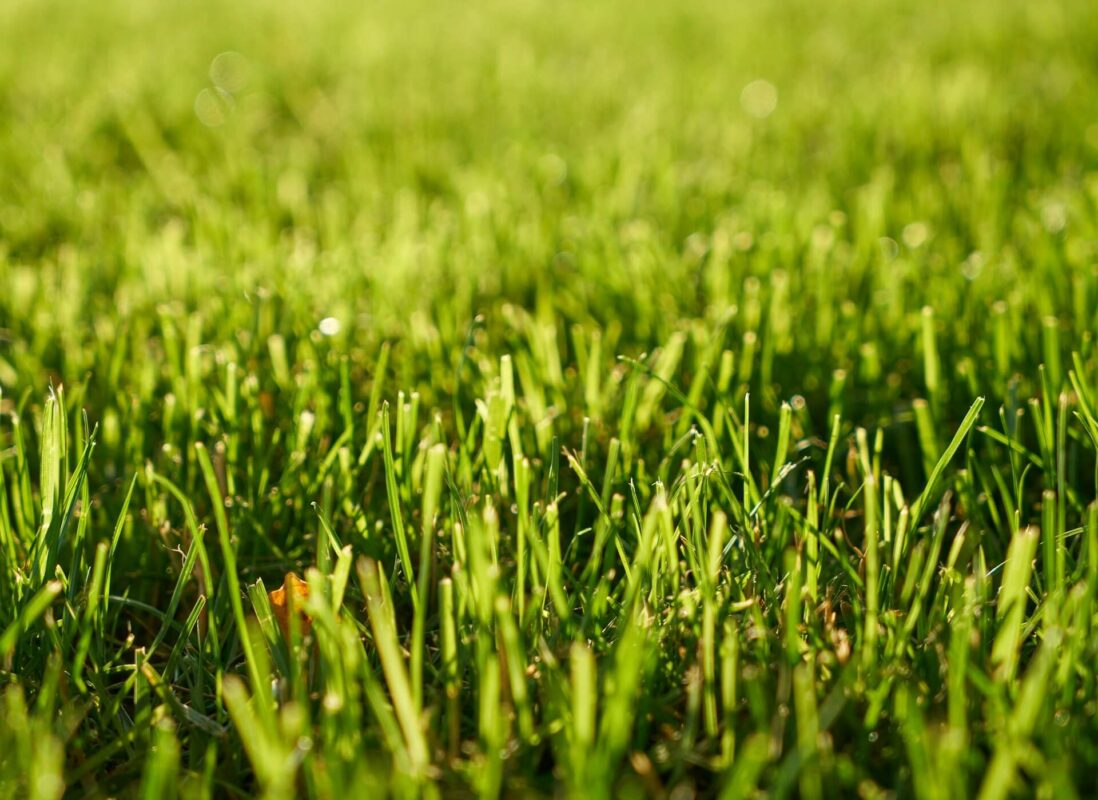How to Prepare Soil for Grass Seed

It’s no secret that a beautiful grass lawn turns heads.
Before you plant grass seed, though, you need to prepare the soil. This preparation will help you avoid mistakes and get the best results.
What mistakes do people make when planting grass seed? There are a lot, ranging from planting the wrong type of seed to skipping important soil tests. No soil will ever be perfect, but with some extra prep, your lawn and outdoor spaces will be green and growing in no time. And in this guide, we’re going to show you everything you need to do to prepare your soil, setting your lawn up for future success.
Chapter 1 – Test Your Soil’s pH
Set the Right Foundation for Your Grass Lawn by Testing Your Soil’s pH
Soil is the foundation for any grass seed. It’s how they receive nutrients. Knowing the pH of your soil helps determine how to improve your soil for your lawn grass seed.
A pH test will determine how acidic or alkaline the soil is. It’s measured on a scale of 1 to 14 with 7 being neutral. Below 7 is considered acidic and above 7 is considered alkaline. The majority of plants prefer a neutral soil. Not only does a soil test determine its pH attributes, it also reveals what is missing from the soil.
Testing Soil pH with a Testing Meter
There are several ways to test the pH level of your soil. Testing meters are inserted into the soil and offer a result. Another option is a testing kit wherein you would prepare samples and send them off for analysis. Then you’ll need to interpret the soil report.
DIY Soil pH Testing
One more option is using vinegar and baking soda to test soil pH levels. Simply collect 1 cup of soil from different areas of your lawn, split into separate cups. Then, add ½ cup of vinegar to one cup and ½ cup of baking soda into the other. The soil’s reaction to these elements can help you determine if the soil is acidic or alkaline. If the soil reacts to the vinegar, it’s more alkaline. If it reacts to the baking soda, it’s more acidic.
No matter which method you use, it’s a good idea to test your soil only when it’s dry as wet soil won’t yield accurate results. After you have your results, it’s time to improve it with planting aids.
Important: Grass prefers a pH range of 6.5-7.0. If more acidic (below 6.5) or more alkaline (above 7), you’ll want to adjust.
How to Raise the pH Levels in Acidic Soil
Lime: Limestone is the most common soil additive for raising soil pH levels. You’ll typically see calcitic limestone (mostly calcium carbonate) and dolomitic limestone (adds magnesium to the mix). Both are equally effective at raising pH levels of soil, although there are a few things to consider:
- Dry vs Damp Lime:
Damp lime reacts quicker than dry lime. This is due to the fact that water reacts with lime to neutralize the pH. It is also much more efficient when it comes to spreading evenly. The drawback is that it’s much more labor intensive.
Dry lime is both more efficient and more affordable. It goes great with agricultural equipment and is easily transported. For large projects, dry lime is a better financial move. On top of that, dry lime can balance your soil’s pH levels in just one application. - Pulverized vs Pelletized Lime:
Pulverized lime is best applied during moist weather. That’s because windy and dry conditions can cause it to scatter, making it less evenly-spread. Pulverized lime is best for large fields.
Pelletized lime on the other hand is easier to spread if you don’t own large-scale agricultural equipment. It also typically reacts faster because it is processed thoroughly before being pelletized. Finally, pelletized lime isn’t vulnerable to windy or dry conditions. - Wood Ash:
This is a more organic approach to raising soil pH levels. Simply sprinkle approximately 1/2 inch of wood ash over your soil and mix it into the soil about a foot deep. While this method does take longer (smaller applications over multiple years), it is very effective. It’s also convenient if you have extra fireplace ashes that need recycling!
How to Lower the pH Levels in Alkaline Soil
- Organic Matter:
There are many types of organic matter that will gradually lower your soil pH over time. These include compost, composted manure and acidic mulches (i.e. pine needles). Soil pH levels are lowered over time as these materials decompose and bacteria grow. While not the fastest-acting solution whatsoever, this method is great for long-term goals (many gardeners will add organic matter annually to lower pH levels subtly throughout the year). Organic matter can also improve soil drainage and aeration. - Sulfur:
Compared to some other methods (Aluminum Sulfate in particular), Sulfur is generally cheaper, more powerful (when it comes to amount needed) and slower-acting. That’s because it must be metabolized by bacteria in the soil to turn to sulfuric acid, which can take up to several months. - Aluminum Sulfate:
Aluminum Sulfate rapidly lowers soil pH levels. In fact, this is one of the quickest-acting options available. That’s because it produces soil acidity as soon as it dissolves. In essence, that means it works instantly. Do not use aluminum sulfate, however, for large applications. It can result in aluminum accumulation and aluminum toxicity.
Chapter 2 – Materials You Need
All the Materials You’ll Need for the Greenest Grass Possible:
- Rotary tiller
- Rakes
- Shovels
- Timer
- PVC pipe
- Anti-siphon valve
- Grass seed
- Fertilizer
- Spreader
Throughout the process of growing the greenest grass, you’ll need several different tools.
A rotary tiller is a must-have to break up the old topsoil. Other tools you should have for the task are: rakes and shovels. If installing sprinklers, include a timer, PVC pipe, and an anti-siphon valve to your list.
Materials needed will be the grass seed itself and fertilizer to add once the seeds are placed. Consider a spreader for dispersing the grass seed over large areas.
Chapter 3 – Soil Preparation Tips
All-Inclusive Soil Preparation Tips
Now that you know your soil’s pH level, it’s time to prepare the soil for the grass seed. Preparing the soil is critical to ensuring your seed suc-cessfully takes root. When you combine a healthy soil with the best grass seed for your region, you are likely to have the results you expect.
- STEP 1: Clear the area you are preparing
Using a rotary tiller makes this easy. With the tiller, apply it to the top six inches. This action augments the soil with oxygen and will also break apart any compacted areas - STEP 2: Rake the soil to remove sticks, debris, and old grass
You’ll need to get this old grass out as it can poison the roots of your new grass seed. - STEP 3: Spray the area with water once clean of debris
- STEP 4: Use the till to add in some nutrients and organic matter
These include compost, yard waste or a slow-release fertilizer.
Chapter 4 – Setting Up a Sprinkler System
The Proper Way to Set up a New Sprinkler System for Perfectly Watered Plants
- Access the Water Line
First access the water line, preferably from an existing spigot. At this time, also install the anti-siphon valve, which prevents any chemicals or brackish water feeding back into the main water supply. - Digging
Now to the digging. Create a trench six to eight inches deep—it’s possible with shovels but rent a trenching device to make it easier. Next, install the valve manifold to the main water line. Remember to tighten the clamps here. - PVC Pipe
Running the PVC pipe is the next step. Install these in the trench using connectors off of the main pipe. After all the pipe is laid, it’s time to affix the sprinkler heads. You should strategically place these depending on the grass water needs. - Finishing Touches
Flush out the system to remove any debris before you put the heads on. Make sure the heads are level with the soil. Then, fill in trenches and holes with dirt. Complete the project by installing a controller that includes a timer. Be efficient in lawn watering to use the least amount possible.
Chapter 5 – The Best Time to Plant
The Absolute Best Time of Year to Plant Grass Seed
While you may have an idea of when you should plant, you’ll almost always have better results if you plant at the seed’s natural period of active growth. But the ‘when’ depends upon which seed you choose.
Cool-season grasses like Kentucky bluegrass and fescue do better when it’s a bit cooler. So, think late summer to early fall. Warm season grasses like Bermudagrass or Bahia grass do best in warmer temperatures of late spring to early summer. Here’s a quick breakdown of when to plant the most popular grass seeds.
- Buffalo – Late Spring (soil temperature between 60-80 degrees)
- Bahia – Spring and Early Summer (will not germinate in cold soil)
- Bermudagrass – Spring and Early Summer (soil temperature is above 65 degrees)
- Zoysia – Spring and Early Summer (soil temperatures above 70 degrees)
- Kentucky Bluegrass – Fall (soil temperature is between 50-65 degrees)
- Perennial Ryegrass – Fall (soil temperature is between 50-65 degrees)
- Fescue – Fall (soil temperature is between 60-75 degrees)
Chapter 6 – How the Pros Plant Grass Seed
Looking for some expert tips on how to plant grass seed? Consider these best practices:
- Purchase a high-quality grass seed
- Disperse the seed by hand in small areas
- Use a spreader for larger areas
- Spread at least 16 seeds per square inch for consistency of growth
- Cover the seeds with a quarter inch of soil
- Apply a planting aid or fertilizer
Chapter 7 – Best Lawn Based on Region
Create the Best Lawn Based on Your Region
Find out the best grass seed by region and make your choice from this list. Using seeds specially designed for an area takes into consideration soil type, water needs, and climate. There are warm- and cold-season seeds. There are multiple grass seed options for either warm or cold climates
The regions of the U.S. are divided based on the characteristics of that area from the Florida tropics to the Pacific Northwest . There is a right grass seed for your lawn so always go with what’s recommended for your region.
When you understand the basics of your soil and what grass seed works best for your region, you are on the right path to success. Let NatureSeed help you along the way. At NatureSeed, you’ll find everything you need to get growing. Get started today by checking out all our best-selling lawn seed products.

